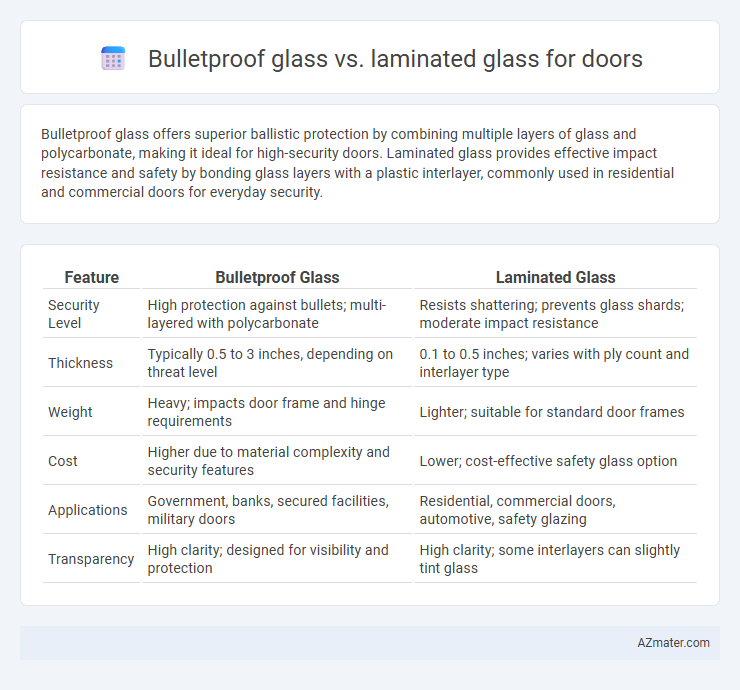Bulletproof glass offers superior ballistic protection by combining multiple layers of glass and polycarbonate, making it ideal for high-security doors. Laminated glass provides effective impact resistance and safety by bonding glass layers with a plastic interlayer, commonly used in residential and commercial doors for everyday security.
Table of Comparison
| Feature | Bulletproof Glass | Laminated Glass |
|---|---|---|
| Security Level | High protection against bullets; multi-layered with polycarbonate | Resists shattering; prevents glass shards; moderate impact resistance |
| Thickness | Typically 0.5 to 3 inches, depending on threat level | 0.1 to 0.5 inches; varies with ply count and interlayer type |
| Weight | Heavy; impacts door frame and hinge requirements | Lighter; suitable for standard door frames |
| Cost | Higher due to material complexity and security features | Lower; cost-effective safety glass option |
| Applications | Government, banks, secured facilities, military doors | Residential, commercial doors, automotive, safety glazing |
| Transparency | High clarity; designed for visibility and protection | High clarity; some interlayers can slightly tint glass |
Introduction to Safety Glass for Doors
Bulletproof glass and laminated glass are essential safety glass options for doors, each offering unique protection levels. Bulletproof glass consists of multiple layers of laminated glass and polycarbonate, designed to withstand high-velocity impacts and ballistic threats. Laminated glass features two or more glass layers bonded with an interlayer, providing strength and preventing shattering upon impact while enhancing security and durability.
What is Bulletproof Glass?
Bulletproof glass, also known as ballistic glass, is a multi-layered system of laminated glass and polycarbonate materials designed to resist high-velocity impacts from bullets. It features thicker, reinforced layers compared to laminated glass, providing superior protection against firearms and ballistic threats. Commonly used in security doors, bulletproof glass combines durability and transparency to safeguard against forced entry and gunfire.
What is Laminated Glass?
Laminated glass is a safety glass consisting of two or more layers of glass bonded together with an interlayer, typically polyvinyl butyral (PVB), which holds the glass pieces in place when shattered. This construction enhances security by providing resistance to impact and penetration, making it suitable for doors where protection and visibility are required. Unlike bulletproof glass, laminated glass offers moderate strength and safety features but does not provide the same level of ballistic resistance.
Key Differences Between Bulletproof and Laminated Glass
Bulletproof glass consists of multiple layers of laminated glass and polycarbonate designed to withstand high-velocity ballistic impacts, while laminated glass primarily offers enhanced safety by holding shattered pieces together upon breakage. Bulletproof glass features a thicker, multi-layered structure tailored for ballistic resistance, unlike laminated glass, which focuses on impact resistance and shatterproofing without stopping bullets. The key differences lie in their material composition, thickness, and protective capabilities, with bulletproof glass providing superior security for doors in high-risk environments compared to standard laminated glass.
Security Performance: Bulletproof vs Laminated Glass
Bulletproof glass offers superior security performance with its multi-layered construction of polycarbonate and glass, designed to withstand high-velocity ballistic impacts, making it ideal for maximum protection in doors. Laminated glass, composed of two or more glass layers bonded with a durable interlayer, provides effective resistance against forced entry and shattering but is less capable of stopping bullets compared to bulletproof glass. For doors requiring advanced security against firearms, bulletproof glass ensures enhanced threat mitigation, whereas laminated glass delivers strong protection against break-ins and impacts.
Durability and Impact Resistance Comparison
Bulletproof glass outperforms laminated glass in durability and impact resistance due to its multi-layered construction combining polycarbonate and glass, designed to absorb and dissipate high-velocity impacts such as bullets. Laminated glass, consisting of two or more glass layers bonded with a plastic interlayer like PVB, offers excellent resistance to shattering and penetration from blunt force but falls short against ballistic threats. For door applications requiring maximum protection against forced entry and ballistic impacts, bulletproof glass provides superior strength and resilience compared to laminated glass.
Cost Analysis: Bulletproof vs Laminated Glass for Doors
Bulletproof glass for doors typically costs between $100 to $150 per square foot, while laminated glass ranges from $25 to $50 per square foot, making laminated glass a more budget-friendly option. The higher price of bulletproof glass is justified by its superior multi-hit ballistic resistance and durability. For cost-sensitive projects where impact resistance is still important, laminated glass offers an affordable balance of security and aesthetics.
Installation Requirements and Compatibility
Bulletproof glass requires a reinforced door frame and precise installation to support its weight and ensure maximum ballistic protection, often involving specialized mounting hardware. Laminated glass offers greater compatibility with standard door frames and can be installed without extensive structural modifications, making it a more versatile choice for both residential and commercial settings. Proper alignment and sealing are crucial in both types to maintain security and insulation performance.
Aesthetic and Design Considerations
Bulletproof glass offers a sleek and modern aesthetic with its typically clear, thick layers that maintain transparency without compromising security, making it ideal for contemporary door designs. Laminated glass, characterized by its multiple thin layers bonded with plastic interlayers, allows for versatile design options including tinted, patterned, or frosted finishes that enhance privacy and style. Both options provide safety but laminated glass offers greater customization for aesthetic appeal, while bulletproof glass emphasizes a minimalist, bold look suitable for high-security entrances.
Choosing the Right Glass for Your Door: Key Takeaways
Bulletproof glass offers superior impact resistance and security, making it ideal for high-risk environments, while laminated glass provides effective shatter resistance and UV protection, suitable for everyday residential doors. Consider factors such as safety requirements, budget, weight, and desired aesthetic when selecting between bulletproof and laminated glass options. Prioritizing the specific performance characteristics and installation demands of each glass type ensures optimal protection and functionality for your door.

Infographic: Bulletproof glass vs Laminated glass for Door
 azmater.com
azmater.com